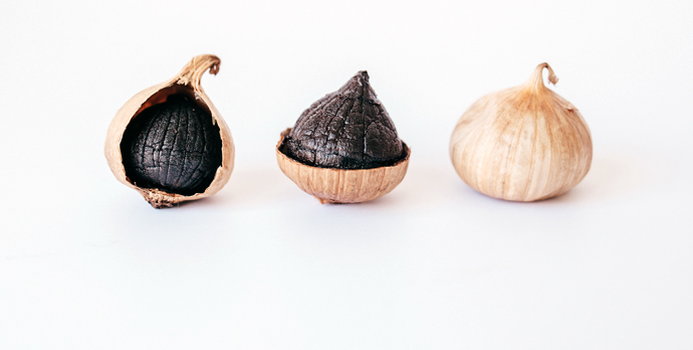When you are trying to eat healthy, you may find it difficult to infuse flavor into less-indulgent foods such as unseasoned chicken breast or plain vegetables. Problem solved! Let me introduce you to your new secret weapon in the kitchen: black garlic.
Black garlic does not look all that appetizing. In fact, it looks like regular garlic that has gone bad and rotted. However, this culinary cache should be treasured. Black garlic comes from regular garlic that has been aged under a very specific set of conditions (stored for weeks at low temps in a humid area), which turns the cloves an inky-black color and changes the texture so that it's sticky, almost date-like in nature. These conditions also promote the Maillard reaction, a chemical process between a sugar and an amino acid. The Maillard reaction results in the creation of hundreds of different flavor compounds. You have likely tasted the delicious end-products of the Maillard reaction if you have ever eaten seared or roasted meat, toasted bread, caramelized onions, caramel, beer, chocolate, coffee, or maple syrup.
How to Use It
Black garlic is softer than regular white garlic but this means you can more easily slice or mince it. But how does it taste, you might wonder? I took a big bite of it, just to get a taste of it right away—unadulterated—since my plan was to eventually use it in a stir-fry. I would describe it as tasting very mild, sweet, and earthy, with notes of plum. I would definitely recommend you use it in any dish that calls for fresh garlic as its more mild, sweet flavor should be relished. Aging the garlic brings out such rich, unique, subtle flavors that you must really experience it for yourself.
Black garlic would work wonders in sauces, salad dressings, condiments, sautéed dishes, soups, grilled meats, and tons of other savory preparations. You can use black garlic anytime you want to impart delicious, earthy, roasted garlic flavor without the bitter burn for which raw garlic is known. I like to purée them with olive oil and spread it on crusty bread.
Nutritional Benefits
Black garlic contains about twice as many antioxidants as raw garlic, including one called s-allycysteine. A sizable number of pharmacological studies discovered that aged garlic extract and its constituents have antioxidant, anti-aging, immune-enhancing, heart protective, and liver protective properties. It can also help prevent tumor and allergic reactions.
One tablespoon (15 grams, 0.5 ounces) of black garlic contains 35 calories, 0 grams of fat, 0 milligrams of sodium, 8 grams of carbohydrate, and 1 gram of protein. Since it packs so much yummy flavor, using black garlic can help you stick to your healthy eating goals because you won't have to add excess fat, salt, or sugar to make your healthy food taste good.
Where Can You Buy It?
I bought some black garlic at good ol’ Trader Joe’s. It came in a small plastic pouch titled “Sweet & Mild Fermented Japanese Aomori Black Garlic” and contained 3 full heads of black garlic, a net weight of 1.76 ounces (50 grams). The cashier told me this was one of their “seasonal” items, meaning they only sell it a few months out of the year and it is not really available year-round. Black garlic can be bought in a variety of forms, including entire heads, conveniently peeled cloves, and powdered. Seek out this culinary gem in specialty spice stores, Whole Foods markets, and Trader Joe’s, or order it online through Amazon or Black Garlic City.
[Image via Shutterstock]



